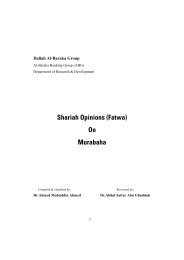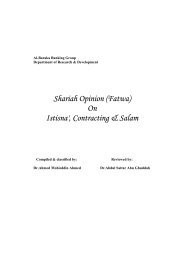Annual Report 2012 - Al Baraka Investment and Development
Annual Report 2012 - Al Baraka Investment and Development
Annual Report 2012 - Al Baraka Investment and Development
Create successful ePaper yourself
Turn your PDF publications into a flip-book with our unique Google optimized e-Paper software.
president & chief executiVe’s report<br />
(continued)<br />
BAnqUe <strong>Al</strong> BARAKA d’<strong>Al</strong>geRie s.p.A.<br />
Founded 1991<br />
Partly on account of reduced trade with the eurozone, <strong>Al</strong>geria’s<br />
main trading area, the country’s GDP growth was a little less<br />
than in 2011, at an estimated 2.6%. The rate of inflation however<br />
surged to an estimated 8.9%, well above the 4.5% experienced<br />
in recent years. The current account surplus continued to grow<br />
as a result of consistently high oil <strong>and</strong> gas revenues <strong>and</strong> steady<br />
non-hydrocarbon economic growth. Foreign exchange reserves<br />
now st<strong>and</strong> at around $90 billion, compared with total external<br />
debt of only $2.5 billion or 1.2% of GDP.<br />
<strong>Al</strong>geria’s huge hydrocarbon reserves <strong>and</strong> ongoing revenues has<br />
allowed the government to continue with its long term strategy of<br />
investing in projects benefiting the <strong>Al</strong>gerian people <strong>and</strong> reducing<br />
unemployment. Increased inward foreign investment, encouraged by<br />
a reformed, more flexible <strong>and</strong> simplified taxation system including<br />
five years’ tax relief for new projects, has been partly responsible<br />
for the increased infrastructure development. However, the main<br />
impetus behind capital spending increases has been the government’s<br />
current 5-year $286 billion development programme, aimed at<br />
developing the non-hydrocarbons industries <strong>and</strong> the services<br />
sector, increasing housing <strong>and</strong> reducing unemployment, which<br />
is funded largely by the banking sector but which, if necessary,<br />
could draw on the estimated $74 billion oil stabilisation fund.<br />
The Central Bank increased the cash reserve rate for banks from<br />
9% to 11%, while their capital adequacy ratio is required to be<br />
maintained at 21%.<br />
In <strong>2012</strong> <strong>Al</strong> <strong>Baraka</strong> <strong>Al</strong>geria’s total assets rose by 5% to $1.84 billion,<br />
with increased liquid assets offset by a 2% decline in total financings<br />
<strong>and</strong> investments. The Murabaha financings, the largest component<br />
of financings, fell by 17% to $434 million, although this was partly<br />
40 <strong>Annual</strong> <strong>Report</strong> <strong>2012</strong><br />
Return to Contents<br />
compensated by a 41% increase in Ijarah Muntahia Bittamleek at<br />
$199 million. The drop in Murabaha turnover was the continuing<br />
consequence of the stringent regulations introduced by the Central<br />
Bank in 2010 to curb personal debt in <strong>Al</strong>geria. The asset growth<br />
was funded by a 9% increase in customer deposits.<br />
Reflecting this decline in Murabaha business, <strong>Al</strong> <strong>Baraka</strong> <strong>Al</strong>geria’s<br />
total income from joint financings <strong>and</strong> investments fell by 11%<br />
to $52 million. However, the share attributable to the IAH was<br />
only 6% below that of the previous year, so that the bank’s share,<br />
including its share as Mudarib, was $32 million, 14% lower than in<br />
2011. Fees <strong>and</strong> banking commissions <strong>and</strong> other operating income<br />
were together only 8% higher – a 39% increase in letters of credit<br />
turnover – so that total operating income ended the year at<br />
$111 million, little changed from 2011. Total operating expense<br />
was 1% higher at $36 million, leaving a net operating income of<br />
$75 million <strong>and</strong>, after significantly lower provisions <strong>and</strong> somewhat<br />
higher taxation charge, producing a net profit of $54 million, 4%<br />
higher than that for 2011. The growth in <strong>Al</strong>gerian Dinar was much<br />
higher at 11% as the <strong>Al</strong>gerian Dinar fell by around 5% against the<br />
US Dollar in <strong>2012</strong>.<br />
<strong>Al</strong> <strong>Baraka</strong> <strong>Al</strong>geria continued to develop its product range. In addition<br />
to rolling out its successful microfinance facility product across<br />
the whole country, it launched new Takaful insurance services <strong>and</strong><br />
an Ijara for rental payments. It has also completed the preparatory<br />
work for the introduction in 2013 of a new Hajj <strong>and</strong> Umrah savings<br />
product as well as a financing product specifically designed for<br />
very small enterprises (VSEs). Its Visa card will be able to offer cash<br />
advances to travellers abroad from the middle of 2013. Once its<br />
core banking system is fully implemented it will launch a variety<br />
of e-banking services. During the last quarter of <strong>2012</strong>, <strong>Al</strong>geria<br />
opened one more branch to exp<strong>and</strong> its network. 2013 will also<br />
see the opening of 4 new branches, bringing the network up to<br />
30, with 45 planned by 2017.<br />
(<strong>Al</strong>l figures in US Dollars unless otherwise stated)




